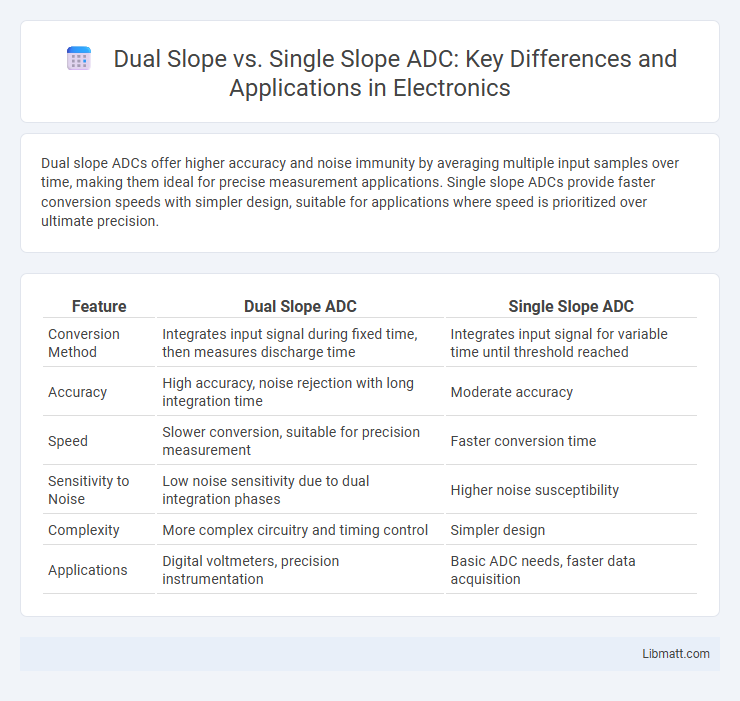Dual slope ADCs offer higher accuracy and noise immunity by averaging multiple input samples over time, making them ideal for precise measurement applications. Single slope ADCs provide faster conversion speeds with simpler design, suitable for applications where speed is prioritized over ultimate precision.
Table of Comparison
| Feature | Dual Slope ADC | Single Slope ADC |
|---|---|---|
| Conversion Method | Integrates input signal during fixed time, then measures discharge time | Integrates input signal for variable time until threshold reached |
| Accuracy | High accuracy, noise rejection with long integration time | Moderate accuracy |
| Speed | Slower conversion, suitable for precision measurement | Faster conversion time |
| Sensitivity to Noise | Low noise sensitivity due to dual integration phases | Higher noise susceptibility |
| Complexity | More complex circuitry and timing control | Simpler design |
| Applications | Digital voltmeters, precision instrumentation | Basic ADC needs, faster data acquisition |
Introduction to ADC Architectures
Dual slope ADCs offer higher accuracy and noise rejection by integrating the input signal over a fixed period, making them ideal for precision measurements like digital multimeters. Single slope ADCs convert analog signals to digital by measuring the time it takes for a linear ramp voltage to match the input, resulting in simpler design but lower noise immunity. Both architectures balance trade-offs between resolution, conversion speed, and complexity, with dual slope favoring precision and single slope emphasizing speed and simplicity.
What is a Single Slope ADC?
A Single Slope ADC converts an analog signal to digital by charging a capacitor with a constant current and measuring the time required for the voltage to reach the input signal level. This method uses a single ramp voltage and a counter to record the elapsed time, resulting in a simple architecture but slower conversion speed. Single Slope ADCs offer high resolution and accuracy but are less efficient compared to Dual Slope ADCs due to susceptibility to noise and voltage reference stability.
What is a Dual Slope ADC?
A Dual Slope ADC converts an analog input voltage into a digital output by integrating the input signal over a fixed time interval, followed by a controlled de-integration period using a reference voltage. It offers high accuracy and noise rejection by averaging the input signal during the integration phase, making it ideal for precise measurements in digital multimeters and industrial instruments. The dual slope method provides superior resolution compared to Single Slope ADCs by minimizing errors due to voltage fluctuations and component tolerances.
Working Principle of Single Slope ADC
Single Slope ADC operates by integrating the input voltage over a fixed time interval using a ramp signal generated by a constant current source. The conversion time is measured by counting clock pulses until the integrated voltage matches the input voltage, allowing the digital output to represent the analog input. Your choice of Single Slope ADC is often driven by its simplicity and low component count, making it suitable for low-speed, high-resolution applications.
Working Principle of Dual Slope ADC
The Dual Slope ADC operates by integrating the input voltage over a fixed time period, producing a voltage ramp proportional to the input signal. After this integration phase, the circuit reverses polarity to discharge the integrator back to zero, measuring the time taken as the digital output value. This method minimizes noise and improves accuracy, making it highly suitable for precise low-frequency signal conversion in your applications.
Accuracy Comparison: Dual Slope vs Single Slope
Dual Slope ADCs offer superior accuracy compared to Single Slope ADCs due to their noise rejection capabilities and integration method, which averages input signal over time. Single Slope ADCs are more susceptible to noise and comparator offset errors, leading to lower precision and stability in measurements. The integration time in Dual Slope ADCs enhances resolution and reduces quantization errors, making them ideal for high-accuracy applications.
Speed and Conversion Time Analysis
Dual slope ADCs offer slower conversion speeds compared to single slope ADCs due to their integration and de-integration phases requiring more time for accurate measurements. Single slope ADCs typically have faster conversion times but may sacrifice accuracy and noise immunity, which are strengths of dual slope designs. Your choice depends on whether speed or precision is prioritized in the application.
Noise Immunity and Signal Integrity
Dual slope ADCs offer superior noise immunity and enhanced signal integrity compared to single slope ADCs due to their integration phase, which averages out noise over time. This integration reduces the impact of high-frequency interference, providing more accurate and stable conversion results. Your choice of ADC can significantly impact measurement precision in noisy environments, making dual slope ADCs ideal for applications requiring high fidelity.
Applications of Dual Slope and Single Slope ADCs
Dual slope ADCs are widely used in digital multimeters and precision measurement instruments due to their high noise rejection and accuracy in low-speed applications. Single slope ADCs find applications in embedded systems and microcontroller-based projects where simplicity and moderate resolution are sufficient, typically in battery-powered devices. Both ADC types are favored in environments requiring low-cost and stable conversion, but dual slope excels in precise, low-frequency signal acquisition.
Choosing the Right ADC: Dual Slope vs Single Slope
Dual slope ADCs offer high accuracy and noise rejection, making them ideal for precision measurements in applications like digital multimeters. Single slope ADCs provide faster conversion times but typically suffer from lower resolution and increased susceptibility to noise. Selecting between dual slope and single slope ADCs depends on the trade-off between speed and accuracy required by the specific application.
Dual Slope vs Single Slope ADC Infographic

 libmatt.com
libmatt.com